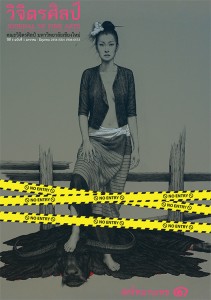ศิลปะ-สถาปัตยกรรมสมัยรัชกาลที่ 1: แนวคิด คติสัญลักษณ์ และความหมาย ทางสังคมยุคต้นรัตนโกสินทร์
Main Article Content
Abstract
ผลการวิจัยพบว่าในยุคสมัยนี้ได้มีการยก “คติพระอินทร์”ขึ้นเป็นอุดมการณ์ใหม่ของรัฐ มีการใช้สัญลักษณ์ “ศีรษะแผ่นดิน” ในฐานะศูนย์กลางของโลกแทนที่ “เขาพระสุเมรุ” คตินิยมดังกล่าวได้ถูกนำเสนอผ่านรูปแบบงานศิลปะและสถาปัตยกรรมรูปแบบใหม่ 3 ประการซึ่งแตกต่างออกไปจากรูปแบบงานศิลปะและสถาปัตยกรรมในสมัยอยุธยาตอนปลาย ประการแรก คือ คตินิยมในการสร้างระเบียงคดล้อมรอบพระอุโบสถซึ่งไม่เคยปรากฏมาก่อนในสมัยอยุธยา ประการที่สอง คือ ความนิยมใน “คติพระอินทร์” ที่นำมาซึ่งการสร้างงานศิลปะและสถาปัตยกรรมที่ปรากฏรูปสัญลักษณ์ของพระอินทร์เป็นจำนวนมาก และประการที่สามคือ พระราชนิยมใน “พระพุทธรูปปางสมาธิ” ของรัชกาลที่ 1 แตกต่างจากคตินิยมเดิมในสมัยอยุธยาที่นิยม “พระพุทธรูปปางมารวิชัย” ผลของงานวิจัยนำมาสู่ข้อสรุปใหม่ที่โต้แย้งกับข้อเสนอเดิมในวงวิชาการทางประวัติศาสตร์ศิลปะและสถาปัตยกรรมที่เชื่อว่างานศิลปะและสถาปัตยกรรมในสมัยรัชกาลที่ 1 คือ งานศิลปะและสถาปัตยกรรมที่เน้นการจำลองหรือลอกเลียนแบบงานช่างจากสมัยอยุธยาตอนปลาย
Art and Architecture in the Reign of King Rama I: Concept, Symbolism, and Socail Meaning of Early Rattanakosin Period.
This research studies Siamese art and architecture during the reign of King Phra Buddha Yodfa Chulaloke (Rama I, 1782 - 1809), the first king of the Chakri Dynasty. The focus is on ways in which the new state instilled its identity, ideology, symbolism and social meaning into works of art and architecture. The main features of this Early Rattanakosin Era were the establishment of ‘Belief in Indra’ as the ideology of the state, and the replacement of Mount Meru by Sisa- Pandin (The head of the land) as the centre of the world.
This study suggests that these new emerging ideas extended into aspects of art and architecture, making them distinctive from those of the late Ayutthaya period in at least three aspects. First of all, the ordination hall is encircled by rabIengkhot (gallery) in its compound, a particular combination unprecedented in Ayutthaya period; secondly, a significant number of works of art and architectural elements were made to depict the subject of Indra God, or related to Indra God; and thirdly, the principle Buddha Image in the ordination hall is of Mediation gesture, rather than Maravijaya posture as usually found in Ayutthaya period. The research draws upon archival sources, such as Tribhumilokkavinichayakatha (one of the most important literatures during the reign of King Rama I), the Traibhumi painting manuscript, chronicles, and upon first-hand analysis of works of art and architecture at Wat Phra Chetuphon, Wat Phra Kaeo, Wat Saket, and Wat Rachaburana, Bangkok. The findings reject the accepted view that customarily sees works of art and architecture during the reign of King Rama I as a replica or a direct continuation of those of the late Ayutthaya period. The result will revise existing histories of art and architecture in King Rama I era.


